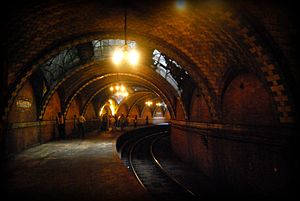City Hall (IRT Lexington Avenue Line)
|
City Hall
|
|
|---|---|
| Former New York City Subway rapid transit station | |
 |
|
| Station statistics | |
| Address | Park Row & City Hall Park New York, NY |
| Borough | Manhattan |
| Locale | Civic Center |
| Line | IRT Lexington Avenue Line |
| Services | None (abandoned) |
| Structure | Underground |
| Platforms | 1 side platform |
| Tracks | 1 balloon loop |
| Other information | |
| Opened | October 27, 1904 |
| Closed | December 31, 1945 |
| Station succession | |
| Next north | Brooklyn Bridge–City Hall |
| Next south | (Terminal) |
|
|
|
|
City Hall Subway Station (IRT)
|
|
| Location | New York City, New York |
| Coordinates | 40°42′48″N 74°00′24″W / 40.71326°N 74.00671°WCoordinates: 40°42′48″N 74°00′24″W / 40.71326°N 74.00671°W |
| Built | 1904 |
| Architect | Heins & LaFarge |
| Architectural style | Romanesque Revival |
| MPS | New York City Subway System MPS |
| NRHP Reference # | 04001010 |
| Added to NRHP | September 17, 2004 |
|
|
|
|
|
City Hall, also known as City Hall Loop, was the original southern terminal station of the first line of the New York City Subway, built by the Interborough Rapid Transit Company (IRT), named the "Manhattan Main Line", and now part of the IRT Lexington Avenue Line. Opened on October 27, 1904, this station, located underneath the public area in front of City Hall, was designed to be the showpiece of the new subway. The platform and mezzanine feature Guastavino tile, skylights, colored glass tilework and brass chandeliers. The Rafael Guastavino-designed station is unique in the system for the usage of Romanesque Revival architecture.
The station was built on a curve and could only accommodate five-car trains, which proved to be inefficient as subway ridership grew. Due to the infrastructural shortfalls, as well as its proximity to the nearby Brooklyn Bridge station, passenger service was discontinued on December 31, 1945, although the station is still used as a turning loop for 6 <6> trains.
The official start of construction took place on March 24, 1900, at the front steps of City Hall, at a ceremony officiated by then-Mayor Robert Van Wyck. After construction was complete, this station was the chosen place for hanging commemorative plaques recognizing the achievement of building the entire New York City Subway system. A mezzanine area above the platform once had an ornamented oak ticket booth (which no longer exists).
...
Wikipedia




